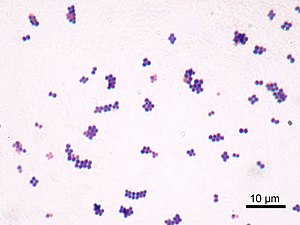mNo edit summary Tags: Visual edit Mobile edit Mobile web edit |
Added more introduction information on shape Tags: Visual edit Mobile edit Mobile web edit |
||
| Line 3: | Line 3: | ||
{{distinguish|Cocchi}} |
{{distinguish|Cocchi}} |
||
[[File:Staphylococcus aureus Gram.jpg|thumb|300px|''Staphylococcus'' bacteria]] |
[[File:Staphylococcus aureus Gram.jpg|thumb|300px|''Staphylococcus'' bacteria]] |
||
A '''coccus''' (plural '''cocci''') is any [[bacterium]] or [[archaeon]] that has a spherical, ovoid, or generally round shape.<ref name="arrangement">{{cite book|last1=Pommerville|first1=J.C.|title=Fundamentals of Microbiology|date=2013|publisher=Jones & Bartlett|location=Sudbury, MA|isbn=9781449647964|page=106|edition= 10th}}</ref><ref name=":0">{{Cite book|url=https://www.worldcat.org/oclc/983825627|title=Sherris medical microbiology|others=Ryan, Kenneth J. (Kenneth James), 1940-|isbn=9781259859809|edition= Seventh|location=New York|oclc=983825627}}</ref> |
A '''coccus''' (plural '''cocci''') is any [[bacterium]] or [[archaeon]] that has a spherical, ovoid, or generally round shape.<ref name="arrangement">{{cite book|last1=Pommerville|first1=J.C.|title=Fundamentals of Microbiology|date=2013|publisher=Jones & Bartlett|location=Sudbury, MA|isbn=9781449647964|page=106|edition= 10th}}</ref><ref name=":0">{{Cite book|url=https://www.worldcat.org/oclc/983825627|title=Sherris medical microbiology|others=Ryan, Kenneth J. (Kenneth James), 1940-|isbn=9781259859809|edition= Seventh|location=New York|oclc=983825627}}</ref> Bacteria are categorized based on their shapes into three classes: cocci (spherical-shaped), [[bacillus (shape)|bacillus]] (rod-shaped) and spirochetes ([[spiral bacteria|spiral-shaped]]) cells.<ref name=":0" /> Coccus refers to the shape of the bacteria, and can contain multiple genera, such as staphylococci or streptococci.<ref name=":1">{{Cite book|url=https://www.worldcat.org/oclc/1032261353|title=Review of medical microbiology & immunology : a guide to clinical infectious diseases|last=Levinson, Warren,|others=Joyce, Elizabeth A., Nussbaum, Jesse,, Schwartz, Brian S., Chin-Hong, Peter,, Preceded by: Levinson, Warren.|isbn=9781259644498|edition=Fifteenth edition|location=[New York]|oclc=1032261353}}</ref> Cocci can grow in pairs, chains, or clusters, depending on their orientation and attachment during cell division.<ref name=":1" /> Contrast to many bacilli-shaped bacteria, most cocci bacteria do not have flagella and are non-motile.<ref name=":1" /> |
||
Cocci is an English [[loanword]] of a [[New Latin|modern or neo-Latin]] noun, which in turn stems from the [[Ancient Greek language|Greek]] masculine noun ''cóccos (κόκκος)'' meaning "berry".<ref>{{LSJ|ko/kkos|κόκκος|ref}}</ref> |
Cocci is an English [[loanword]] of a [[New Latin|modern or neo-Latin]] noun, which in turn stems from the [[Ancient Greek language|Greek]] masculine noun ''cóccos (κόκκος)'' meaning "berry".<ref>{{LSJ|ko/kkos|κόκκος|ref}}</ref> |
||
Revision as of 23:47, 23 August 2019

A coccus (plural cocci) is any bacterium or archaeon that has a spherical, ovoid, or generally round shape.[1][2] Bacteria are categorized based on their shapes into three classes: cocci (spherical-shaped), bacillus (rod-shaped) and spirochetes (spiral-shaped) cells.[2] Coccus refers to the shape of the bacteria, and can contain multiple genera, such as staphylococci or streptococci.[3] Cocci can grow in pairs, chains, or clusters, depending on their orientation and attachment during cell division.[3] Contrast to many bacilli-shaped bacteria, most cocci bacteria do not have flagella and are non-motile.[3]
Cocci is an English loanword of a modern or neo-Latin noun, which in turn stems from the Greek masculine noun cóccos (κόκκος) meaning "berry".[4]
Cocci Structure
Structure for cocci may vary between gram positive and gram negative bacterial wall types.
The cell wall structure for cocci may vary between gram positive (thin peptidoglycan layers) and gram negative (thick peptidoglycan layers). While living in their host organism, cocci can be pathogenic (e.g., streptococcus), commensal, or symbiotic.[2]
Gram-Positive Cocci
The Gram-Positive Cocci are a large group of loosely bacteria with similar morphology. All are the spherical or nearly so, but they vary considerably in size. Members of some genera are identificable by the way cells are attached to one another: in pockets, in chains, or grapes like clusters. These arrangements reflect patterns of cell division and fact that cell stick together. Sarcina cells, for example, are arranged in cubical pockets because cell division alternates regularly among the three perpendicular planes. Streptococcus spp. resemble a string of beads because division always occurs in the same plane. Some of these strings, for example, S. pneumoniae, are only two cells long. They are called diplococci. Species of Staphylococcus have no regular plane of division. They form grapelike structure.[5]
The various Gram-positive cocci differ physiologicaly and by habitat. Micrococcus spp. Are obligate aerobes that inhabit human skin. Staphylococcus spp. also inhabit human skin, but they are facultative anaerobes. They ferment sugars, producing lactic acid as an end product. Many of these species produce carotenoid pigments, which color their colonies yellow or orange. Staphylococcus aureus is a major human pathogen. It can infect almost Any tissue in the body, frequently the skin. It often causes nasocomial(hospital-acquired) infections.[6]
Arrangements
Cocci may occur as single cells or remain attached following cell division. Those that remain attached can be classified based on cellular arrangement:[1]
- Diplococci are pairs of cocci (e.g. Streptococcus pneumoniae and Neisseria gonorrhoeae)
- Streptococci are chains of cocci (e.g. Streptococcus pyogenes).
- Staphylococci are irregular (grape-like) clusters of cocci (e.g. Staphylococcus aureus).
- Tetrads are clusters of four cocci arranged within the same plane (e.g. Micrococcus sp.).
- Sarcina is a genus of bacteria that are found in cuboidal arrangements of eight cocci (e.g. Sarcina ventriculi).
References
- ^ a b Pommerville, J.C. (2013). Fundamentals of Microbiology (10th ed.). Sudbury, MA: Jones & Bartlett. p. 106. ISBN 9781449647964.
- ^ a b c Sherris medical microbiology. Ryan, Kenneth J. (Kenneth James), 1940- (Seventh ed.). New York. ISBN 9781259859809. OCLC 983825627.
{{cite book}}: CS1 maint: others (link) - ^ a b c Levinson, Warren,. Review of medical microbiology & immunology : a guide to clinical infectious diseases. Joyce, Elizabeth A., Nussbaum, Jesse,, Schwartz, Brian S., Chin-Hong, Peter,, Preceded by: Levinson, Warren. (Fifteenth edition ed.). [New York]. ISBN 9781259644498. OCLC 1032261353.
{{cite book}}:|edition=has extra text (help)CS1 maint: extra punctuation (link) CS1 maint: multiple names: authors list (link) - ^ κόκκος. Liddell, Henry George; Scott, Robert; A Greek–English Lexicon at the Perseus Project
- ^ Catherine A. Ingraham, John A. Ingraham (2000). Introduction to Microbiology.
- ^ Catherine A. Ingraham, John L. Ingraham (2000). Introduction to Microbiology.